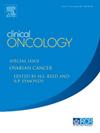基于miR-139、核因子-红细胞2相关因子2和miR-7的胃癌患者术后生存预后Nomogram构建与验证
IF 3
3区 医学
Q2 ONCOLOGY
引用次数: 0
摘要
目的探讨胃癌患者miR-139、核因子红细胞2相关因子2 (NRF2)和miR-7的表达水平与术后生存的关系,并构建nomogram预测模型。材料和方法采用实时荧光定量聚合酶链反应(PCR)检测miR-139和miR-7的表达水平,免疫组织化学检测NRF2的表达水平。分析了这些生物标志物与临床病理特征以及术后生存之间的关系。采用多因素cox回归分析,确定独立预后因素,构建nomogram预测模型。结果生存组与死亡组在肿瘤直径、肿瘤分化、浸润深度、淋巴结转移、TNM分期、miR-139水平、NRF2评分、miR-7水平等方面差异均有统计学意义(P <;0.05)。多因素Cox回归分析显示,淋巴结转移、TNM分期、miR-139为独立危险因素,NRF2、miR-7为独立保护因素。nomogram预测模型预测胃癌患者术后生存因素的曲线下面积(AUC)为0.959 (95% CI: 0.933-0.985)。校正图结果清楚地表明,模型预测值与实际观测值高度吻合,其c指数值为0.959。此外,决策曲线分析(DCA)结果进一步验证了该模型在临床应用中的良好实用性。结论mir -139、NRF2、miR-7是影响胃癌患者术后生存的独立因素。基于此,nomogram预测模型对胃癌患者具有较好的预测效果。本文章由计算机程序翻译,如有差异,请以英文原文为准。
Construction and Validation of a Nomogram for Postoperative Survival Prognosis in Gastric Cancer Patients Based on miR-139, Nuclear Factor Erythroid2-Related Factor 2, and miR-7
Aim
To explore the relationship among the expression levels of miR-139, nuclear factor erythroid2-related factor 2 (NRF2) and miR-7 and postoperative survival in patients with gastric cancer, and to construct a nomogram prediction model.
Materials and methods
The expression levels of miR-139 and miR-7 were detected using real-time fluorescence quantitative polymerase chain reaction (PCR), while NRF2 expression was assessed by immunohistochemistry. The associations between these biomarkers and clinicopathological features as well as postoperative survival were analyzed. Multivariate cox regression analysis was used to identify independent prognostic factors, and a nomogram prediction model was constructed.
Results
There were statistically significant differences in tumour diameter, tumour differentiation, infiltration depth, lymph node metastasis, TNM staging, miR-139 level, NRF2 score, and miR-7 level between survival group and death group (P < 0.05). The multivariate Cox regression analysis showed that lymph node metastasis, TNM stage, and miR-139 were independent risk factors, while NRF2 and miR-7 were independent protective factors. The nomogram prediction model achieved an area under the curve (AUC) of 0.959 (95% CI: 0.933-0.985) in predicting postoperative survival factors in gastric cancer patients. The results of calibration chart clearly show that the predicted values of the model are highly consistent with the actual observed values, and its C-index value is 0.959. In addition, the results of decision curve analysis (DCA) further verified the good practicability of the model in clinical application.
Conclusion
miR-139, NRF2, and miR-7 are independent influencing factors on postoperative survival of patients with gastric cancer. Based on this, the nomogram prediction model shows good prediction performance in patients with gastric cancer.
求助全文
通过发布文献求助,成功后即可免费获取论文全文。
去求助
来源期刊

Clinical oncology
医学-肿瘤学
CiteScore
5.20
自引率
8.80%
发文量
332
审稿时长
40 days
期刊介绍:
Clinical Oncology is an International cancer journal covering all aspects of the clinical management of cancer patients, reflecting a multidisciplinary approach to therapy. Papers, editorials and reviews are published on all types of malignant disease embracing, pathology, diagnosis and treatment, including radiotherapy, chemotherapy, surgery, combined modality treatment and palliative care. Research and review papers covering epidemiology, radiobiology, radiation physics, tumour biology, and immunology are also published, together with letters to the editor, case reports and book reviews.
 求助内容:
求助内容: 应助结果提醒方式:
应助结果提醒方式:


